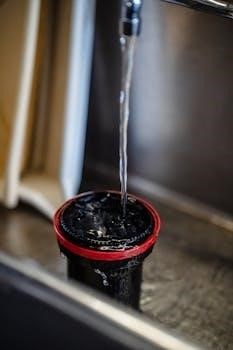
Clack Water Softener Owners Manual⁚ A Comprehensive Guide
Welcome to your comprehensive guide to Clack water softeners! This manual assists owners in understanding, operating, and maintaining their Clack water softener systems. It offers guidance on installation, setup, and troubleshooting for optimal performance and longevity, including regeneration tips.
Clack water softeners are renowned for their reliable performance and innovative control valve technology, designed to efficiently remove hardness minerals from your water supply. Understanding your Clack system is essential for maximizing its benefits and ensuring long-term, trouble-free operation. This section provides an overview of Clack water softeners, their components, and their role in providing softened water throughout your home.
Clack offers various models to suit different household sizes and water usage needs, featuring user-friendly interfaces for easy programming and monitoring. We will explore the key features that make Clack a trusted name in water treatment, including explanations of control valve functions, regeneration processes, and maintenance requirements. Get ready to dive in and discover how to get the most out of your Clack water softener!

Understanding Your Clack Control Valve
The Clack control valve is the brain of your water softener, managing the entire softening and regeneration process. This section will help you understand its functions and how it contributes to efficient water softening.
Clack WS1 Series Overview
The Clack WS1 series is a versatile control valve designed for residential and light commercial water softeners. Known for its reliability and ease of use, the WS1 series offers various programming options to optimize water softening based on individual needs. This series supports both metered and time-clock regeneration.
Its robust design ensures long-lasting performance with minimal maintenance. The WS1 series features user-friendly controls for setting regeneration cycles, adjusting salt dosage, and monitoring system performance. Understanding the specific model within the WS1 series is crucial for proper installation, operation, and troubleshooting. Refer to the specific service manual for model-specific details.
Clack WS1.25 Series Overview
The Clack WS1.25 series builds upon the reliability of the WS1 series, offering enhanced flow rates and features for larger households and commercial applications. This series accommodates higher water demand while maintaining efficient softening performance. Like the WS1, the WS1.25 offers programmable regeneration cycles, including metered and time-clock options, to conserve water and salt.
Its larger valve body allows for increased flow capacity, reducing pressure drop and ensuring consistent water pressure throughout the system. The WS1.25 series also incorporates user-friendly controls for easy adjustment of settings and monitoring of system performance. Consult the specific service manual for detailed specifications and maintenance procedures relevant to your model.
Clack WS1CS Series Overview
The Clack WS1CS series represents a compact and efficient solution for water softening needs, designed with simplicity and ease of use in mind. This series is particularly well-suited for residential applications with moderate water consumption. The WS1CS maintains the robust construction and reliable performance associated with Clack products, offering dependable water softening.
It features a user-friendly interface for straightforward programming of regeneration cycles, optimizing salt usage and water conservation. Its compact design allows for flexible installation options, even in limited spaces. Refer to the WS1CS service manual for detailed instructions on setup, programming, and troubleshooting to ensure proper operation and longevity.
Installation Instructions
Proper installation is crucial for optimal Clack water softener performance. This section details the steps for pre-installation checks, drain line connections, and bypass valve operation, ensuring a smooth and effective setup process.
Pre-Installation Checklist
Before installing your Clack water softener, ensure you have the necessary tools and materials. Verify that the incoming water quality meets the softener’s specified parameters. Check the water pressure, ensuring it falls between 2 and 8 bar. Locate the rising main, a drain facility, and a power supply. Consider regulations concerning water softener installation.
Confirm the correct installation or operation manual for your specific Clack model. Fully open a cold water faucet and allow water to run until clear, removing debris. Ensure the drain line size is adequate, increasing to 3/4″ if the run exceeds 20 feet. Finally, add salt, using only products designed for water softeners.
Connecting the Drain Line
Properly connecting the drain line is crucial for your Clack water softener. The drain line carries wastewater during regeneration. Ensure the drain line’s inner diameter is appropriate. If the distance to the drain exceeds 20 feet, use a 3/4-inch drain line to prevent backpressure.
The drain elbow fitting has 3/4-inch male NPT threads, usable instead of the 1/2-inch plastic nut and insert. If the drain line runs overhead, maintain a maximum height of 8 feet above the water softener’s top. Securely connect the drain line to avoid leaks. Check your local plumbing codes for compliance.
Bypass Valve Operation during Installation
The bypass valve is an essential component during the installation of your Clack water softener. It allows you to isolate the softener from the water system, enabling you to perform maintenance or repairs without disrupting the water supply to your home.
During installation, keep the bypass valve in the bypass position. This directs water around the softener, preventing debris from entering the system while you complete the plumbing connections. After installation, slowly switch the valve to the service position to gradually introduce water to the softener.

Operating Your Clack Water Softener
Effectively operating your Clack water softener involves understanding its controls, settings, and regeneration cycles. This section guides you through the initial start-up, adjusting settings based on water hardness, and setting the regeneration time.
Initial Start-Up Procedure
After installation, initiate the start-up by rotating the bypass handles to the bypass position. Fully open a cold water faucet nearby to run water until clear, removing debris from the pipes that may have accumulated during installation. Ensure the water inlet and outlet are closed before proceeding.
Next, commission the unit by initiating a regeneration to fill the softener and brine tank with water, checking for leaks. This process also helps remove air from the softener, bedding in the resin, and thoroughly flushing the system. Once complete, your system is ready for testing.
Verify the softener is fully functional, ensuring regeneration occurs at the pre-set time.
Setting the Regeneration Time
To program the regeneration time on your Clack water softener, access the control valve settings. The regeneration time determines when the softener will automatically clean its resin bed. This is usually done during periods of low water usage, such as late at night or early morning, to minimize disruption.
Refer to the specific model’s service manual for detailed instructions, as button configurations and menu navigation can vary. Typically, you’ll need to navigate to the programming menu and locate the regeneration time setting. Adjust the hour and minutes to your preferred time and save the settings.
Regular monitoring ensures optimal performance.
Adjusting Softener Settings Based on Water Hardness
Adjusting your Clack water softener settings according to your water hardness level is crucial for optimal performance. Water hardness is measured in grains per gallon (GPG) or parts per million (ppm). Obtain a water hardness test kit or contact your local water supplier to determine your water’s hardness.
Once you know your water hardness, consult the manual to find the appropriate settings for your Clack control valve. Typically, you’ll adjust the capacity setting to reflect the amount of hardness your softener needs to remove between regenerations. Proper settings ensure efficient softening and prevent premature resin exhaustion.
Consult the manual.

Manual Regeneration
Manual regeneration allows you to initiate a regeneration cycle outside the programmed schedule. This can be necessary after periods of high water usage or if you suspect the resin bed is exhausted. Consult your manual for specific instructions.
Initiating a Manual Regeneration Cycle
To start a manual regeneration cycle on your Clack water softener, locate the regeneration button on the control valve. Typically, you’ll need to press and hold this button for a few seconds, usually around three seconds, until the system indicates that it is beginning the regeneration process. The display might change to show a regeneration cycle is in progress.
Ensure that the water inlet and outlet valves are in the correct positions for regeneration. Avoid using water during the regeneration cycle. The system will then go through its programmed steps to clean and recharge the resin bed. Refer to your specific model’s manual for precise instructions.
Why Perform Manual Regeneration?
Manual regeneration of your Clack water softener is essential for several reasons. Primarily, it ensures optimal softener performance, especially after periods of high water usage or if you suspect the resin bed is becoming exhausted. Initiating a manual cycle helps to recharge the resin, restoring its ability to remove hardness minerals effectively.
Additionally, manual regeneration is useful when commissioning a new softener to remove air from the system and bed in the resin. It’s also beneficial if you notice changes in water quality or if you’re preparing the system for periods of inactivity. Regular manual regenerations contribute to the longevity and efficiency of your softener.

Maintenance and Troubleshooting
This section covers vital maintenance for your Clack water softener. Learn how to check salt levels, detect leaks, and prevent issues. This provides guidance on addressing common problems to ensure efficient operation.
Checking and Adding Salt
Maintaining adequate salt levels is crucial for your Clack water softener’s performance. Regularly inspect the brine tank, ensuring the salt level remains above the water level. Use only salt specifically designed for water softeners, such as rock or pellet salt, avoiding common table salt.
If the salt level is low, add a minimum of a 40 lb bag of salt. Consistent salt maintenance ensures effective regeneration, preventing hardness breakthrough and prolonging the resin’s lifespan. Remember to check more frequently depending on your water usage and softener settings. Properly managing salt contributes to optimal water softening and overall system efficiency, preventing potential problems.
Leak Detection and Prevention
Regularly inspecting your Clack water softener for leaks is essential for preventing water damage and maintaining system efficiency. Check all connections, including the inlet, outlet, drain line, and bypass valve, for any signs of moisture or drips. Tighten any loose fittings carefully, avoiding over-tightening to prevent damage.
Ensure the drain line is properly connected and not obstructed, as back pressure can cause leaks. If leaks persist, consider replacing worn-out O-rings or seals. Monitor the area around the softener for dampness or pooling water, indicating potential hidden leaks. Addressing leaks promptly prevents costly repairs and ensures your softener operates optimally.
Troubleshooting Common Issues
Encountering issues with your Clack water softener? This section provides troubleshooting steps for common problems. If your water isn’t softening, check the salt level in the brine tank and ensure the system is regenerating correctly. Unusual noises might indicate valve issues or obstructions; inspect and clean the valve assembly;
Reduced water pressure could stem from resin bed problems or clogged filters; consider backwashing the system or replacing the resin. Error codes on the control panel indicate specific faults; consult the manual for code descriptions and solutions. If problems persist, contacting a qualified technician is recommended for professional diagnosis and repair, ensuring optimal softener performance.